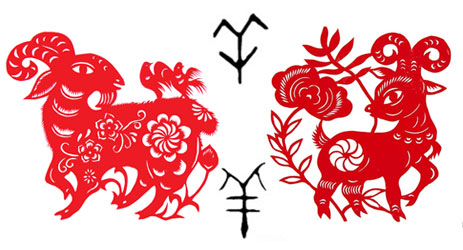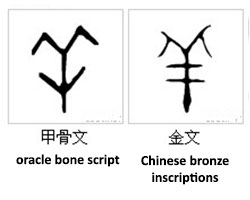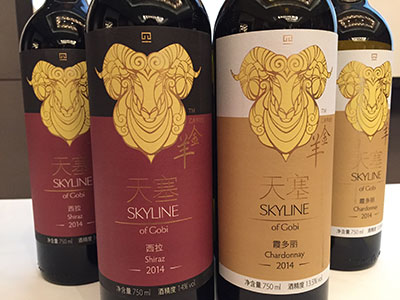Demei's View - Wine Communication from a Chinese Winemaker
We have entered the Year of ‘Yang’ in the Chinese lunar calendar; meaning people who were born in this year shares the Chinese zodiac sign of ‘Yang’. The same zodiac comes back every 12 years. And, just like it is always Tuesday after Monday, Chinese people are used to this recurrence.

There’s nothing special for them apart from the annual celebration. However, something different happened this year, because the Western media wanted to report the celebration of the Chinese New Year. In England, the Manchester Evening News published an article entitled Chinese New Year Manchester: Is it the Year of the Ram/Sheep or Goat? Many other media outlets, including the Birmingham Mail and CNN, have subsequently joined the discussion. I trust the serious attitude and professionalism of these media; if they can point out this question that baffles most Chinese people, there’s no doubt that they are capable to get the answer. But from the perspective of attracting attention, it seems more interesting to leave it for the readers to find out the answer. In fact, during this Spring Festival, all the young people in China were talking about which English word we should use for the Year of ‘Yang’.
Every Chinese remembers his/her Chinese zodiac. Since the Qin Dynasty, we started to mark each year with one of the 12 animals, and every 12 years is a circle. Theoretically, each Chinese zodiac has over 100m Chinese people associate with it.
People who were born in the Year of ‘Yang’ don't know if they are ram, goat or sheep. The confusion exists in many other Chinese zodiacs, except for a few, such as the dragon. Is it rat or mouse for the Year of ‘Shu’; cow, cattle or ox for the Year of ‘Niu’; hare or rabbit for the Year of ‘Tu’; snake or serpent for the Year of ‘She’; chicken or rooster for the Year of ‘Ji’; and pig or hog for the year of ‘Zhu’?

Well, it seems the Chinese and English languages do not correspond very well. The nature of the Chinese characters brings confusion when we try to translate Chinese into English. We know that many Chinese characters are pictographic characters derived from drawing, and there is the theory of the common origin of calligraphy and painting in China. The oldest Chinese characters were the oracle bone script, and after that the Chinese bronze inscriptions. Most characters were simplified or transformed from them. For people who had seen a sheep, it is very easy for them to understand the meaning of the character ‘Yang’ written with the oracle bone script and the Chinese bronze inscriptions. (Image 1)
The origin of the Chinese characters gives them ‘a feature that transcends the different dialects’. China is a big country with many complicated dialects; it is very difficult to promote the standardisation of the language even in now. Qin Shi Huang achieved one of the great inventions in human history by standardising the characters in the Qin empire. The Chinese character has become the general written language and the communication tool. Although we speak in different languages, the writing is all the same.

When we describe something in Chinese, very often there is a generic term for a group of things. For example, the character ‘yang’ refers to a group of animals that share many common characteristics (it isn’t only a joke for the New York Daily News to call it the ‘year of any ruminant horned animal’). There was no explanation of which specific animal ‘Yang’ referred to, when people in ancient China set ‘Yang’ as one of the Chinese zodiacs. It is the same when talking about alcoholic beverages (known as ‘jiu’) with Chinese people. You need to specify which kind of ‘jiu’ you are talking about, because it is translated as ‘wine’ in some dictionaries, which is not precise enough.
This topic is so complicated and the news story of the Western media trying to figure out whether it is the ram, goat or sheep for the Year of ‘Yang’ is not very funny. But, people working in the wine industry should see the business opportunity through it – Chinese people use the special ‘12 Chinese zodiacs’ to mark the years, and this tradition relates to every Chinese person. Wines also get their own vintages. If we combine the concept of vintage with the 12 Chinese zodiacs in the promotion of wines, isn’t it a good example of ‘localised wine marketing’?
The first case I saw was the 2011 Pinot Noir from the China Terrace Vineyard in Gibbston Valley, Central Otago, New Zealand. It has the Chinese character ‘Tu Nian’ (the Year of ‘Tu’) on the label. (2011 was the Year of ‘Tu’ in the lunar calendar. Was it hare or rabbit? People who were born in that year don’t ever think about it; they just need to know it is not the Year of Tiger or Dragon.)(Image 2) Gibbston Valley produces a Pinot Noir like this for every vintage. (Image 3)

Another example of promoting wines with the Chinese zodiacs is the Skyline of Gobi Vineyard (Tiansai Winery) in Xinjiang, China. When the winery produced its first vintage in 2012, it was considering how to adopt more Chinese elements in it. The ‘12’ in the vintage reminded us of the 12-year cycle of the Chinese zodiac, so the limited edition, red and white ‘Chinese zodiac wine’ was born. Xinjiang is in the northern hemisphere, which means that, even with the quickest winemaking technology, it is the end of a year before the wines are ready after the harvest. Therefore, the winery decided to put the upcoming Chinese zodiac on the label and make the wine ‘a wine to welcome the New Year’. (Image 4)
Although it is not possible to target all the Chinese people who have the same zodiac sign, it is not so difficult to find a few hundred consumers in a certain area. Imagine: when you have a birthday party with your family and friends, isn’t it a novel way to celebrate by opening a bottle of your Chinese zodiac wine? This is especially attractive to the young generation. Before the Year of ‘Yang’ arrived, the Skyline of Gobi Vineyard launched its Chinese zodiac wine of the ‘Yang’ in five Chinese cities, and gathered together a lot of consumers with the same zodiac sign. (Image 5)
Next year will be the Year of the Monkey. I think there will be no more confusion in terms of how to translate it.
Translated by Nina Fan Feng / 冯帆
All rights reserved by Future plc. No part of this publication may be reproduced, distributed or transmitted in any form or by any means without the prior written permission of Decanter.
Only Official Media Partners (see About us) of DecanterChina.com may republish part of the content from the site without prior permission under strict Terms & Conditions. Contact china@decanter.com to learn about how to become an Official Media Partner of DecanterChina.com.


Comments
Submit